
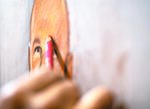



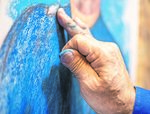
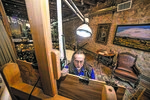
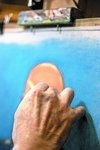
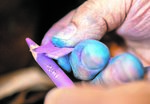
Rows of faces line the long hallways of the Fort Worth Police Academy.
Portraits of fallen officers dating back as far as 1893 hang solemnly as a memorial to their service and sacrifice.
Forever at attention and proudly in uniform, their faces rendered in pastel chalks under glass are both haunting and heroic, an artful display of those killed in the line of duty.
Some of the subjects in the Fort Worth portrait gallery go back to the late 19th century, as well as many who died in the 1910s and 1920s. Their stories were lost until research revealed the cause of their deaths, and the portrait project brought their memories back to life.
The talent behind these portraits is Granbury resident James Spurlock, a 40-year-plus professional artist.
Residing in Granbury for the past 19 years with his wife, Lynda, he has enjoyed the life of art that he chose.
“I feel thankful for the gifts that the Lord Jesus allowed me to have, to develop the skills I needed to do this type of artwork,” Spurlock said.
Spurlock's art is part of the legacy of Hood County. Because of his membership at Lakeside Baptist Church, he became involved with the Living Christmas Cards, created and sponsored by the church. The cards are large panels/murals that serve as a backdrop for the holiday celebration presented on the Granbury Square.
‘HELP START HEALING’
Over the years, he has produced more than 120 portraits for both the Dallas and Fort Worth police departments.
“When someone passes, they leave a hole. ... (Maybe) an icon, an artistic representation of the missing person (will) help start healing the void,” he said.
This is especially true for those officers who are killed in the line of duty.
Retired Fort Worth Police Sgt. Kevin Foster has worked with Spurlock for many years on the project, providing him with background and source material to fill those voids. Many of the source images that Spurlock used as inspiration are the size of a thumbnail. A dim memory of a face, maybe from a family snapshot or a squad photo.
Foster has given Spurlock some pretty tall orders ― to transform these scraps into a full color remembrance of the officer.
“His skill is amazing. For example, we had half a face from an old newspaper photo and I asked him, 'can you finish the other half and put him in uniform?'” Foster said. “And he did it.”
In addition to the police portraits, Spurlock has been doing memorial artwork for private clients since his early days as a professional in the 1970s, using a variety of media to achieve the task.
Today, about 40% of his work is commissions for memorials. It's important work, something of a calling. Spurlock has painted images of a lost loved one, or of family groups where he includes the missing member of the family.
“The family or memorial portraits can be the spark to help a family find strength or regain strength after a tragic occurrence,” he said.
FAMILY OF ARTISANS
Among his many blessings, Spurlock comes from a family of artisans and a rich cultural heritage.
The story of his family begins in Japan, on a blind date between his mother, Shizuko, and father, Charles, who was stationed there in the Air Force. The two married and bounced around the U.S., back to Japan two more times, eventually raising a family of six children.
Spurlock was the firstborn and got the benefit of the many years in Japan, learning to speak the language and soaking up the art and history of the place.
Military life can be isolating but Spurlock found that it led him to be more flexible and develop an objective outlook.
“I had two dichotomous roots,” he said, contemplating his upbringing--Japan and the military--and he simply learned to bloom where he was planted.
“Or as Paul says in the Bible, I'm paraphrasing, 'be content where you are,’” he said. “You find a commonality with people, much more than with people who haven't traveled.”
In addition to his cultural roots, both of his parents were artisans in their own right.
Spurlock's mom was a seamstress, dollmaker and ikebana teacher (Japanese flower arranging). Shizuko was one of the few tailors who was allowed to work on the furs at Neiman-Marcus.
His father designed and upholstered furniture. Charles was something of a perfectionist, as Spurlock recalls him doing an elaborate cover for a 90-inch couch by hand. He ripped it all out and redid it because some detail wasn't quite right.
“I think maybe I learned the skill of using my hands by watching them work ― how they did things and how they approached their art,” Spurlock said.
As a child, art had always been an interest. At 15, Spurlock took an art “test” which triggered a salesman's visit to sell a very expensive art correspondence course to the family. He recalls that his dad said no and told his son to go into the sciences because artists didn’t make any money, and if they did, it wasn’t enough to live on. His art career was on hold.
Spurlock pursued a degree in science and contemplated a career in physical therapy.
In his final year of college, his father bought him a set of books on art to help ease him into art as 'just' a hobby.
“It backfired on him,” he said. “I used science-backed study habits, devoured the books ... and got obsessed.”
‘MY SON, THE ARTIST’
With the Vietnam War winding down, returning medics flooded the physical therapy field, convincing Spurlock it was not the path he wanted.
Instead, he quickly went pro, despite his father's belief that art is not a viable career.
He sold artwork at shows just six months after receiving the books from his father, and three years later, he began teaching, as much to help others as to continue his own self-education.
A turning point came for Spurlock and his father years after he began doing art full-time.
Loaded up with work to take to a show in Colorado, he stopped along the way to show his parents the artwork. His father paid him a rare compliment on a painting of young sisters on horseback, crossing a creek in the dying rays of sundown, called “Shallow Crossing.”
Later at the show, Spurlock made a deal with a woman who took a shine to the piece but could not afford to pay the asking price.
She had an interesting idea for a trade ― a four-year-old 1979 Grand Marquis in mint condition.
“You could eat off the engine,” Spurlock said. “The interior was immaculate. ... I thought it was just gorgeous.”
They negotiated briefly, and Spurlock accepted an even trade.
He drove the Grand Marquis back to Texas, stopping again at his father's upholstery shop.
His father came out of the shop, and asked, “Whose car is that?”
Spurlock told him “Mine. Remember 'Shallow Crossing'? I traded it. Even.”
“Even?”
“Even.”
When it fully sank in that his artwork could be converted into something as useful as a car, his father responded, “My son, the artist!” Spurlock recalls that from that day forward, his father called him “my son, the artist” and was his best supporter, having seen visible proof of the value that art could bring, and that maybe his son could indeed make a living at it.
LIFE AS AN ARTIST
Over the years, Spurlock developed a niche for his painting and sculpting, and has continued his learning process by teaching art.
Currently, he teaches classes using the methods he learned in college as a budding scientist.
“I ask my students questions because maybe I don't have the answer,” he said. “So we figure it out together.”
Spurlock stays humble about his philosophy of teaching.
“I don't teach some gimmick to painting flowers,” he said. “Instead, I teach students to learn how to learn. If you know how to learn, you can teach yourself anything ― that's the key.
“I’m kind of a wallflower. I hang back and observe. I paint that way and I teach that way,” he added.
When asked what has been the hardest part of life as an artist, Spurlock said, “Learning to know yourself. ... How hard can you work for what you want? You've got to have skin in the game, and if you do, how thick is it?”
Spurlock works in a dozen different media. Out of these ― pencil, charcoal, color pencil, oil pastels, pastels, watercolors, acrylics, tempra, gouache, water soluble oils, oils, scratch board, India ink ― his favorite is whatever medium he is working with at the moment.
“I would pick out a medium and learn it,” he said. “Then I would go teach it. Eighty percent of what I knew about that medium I learned from teaching it.”
In addition to the Living Christmas Cards, commission for memorial and other portraits, and classes he teaches in Aledo, Spurlock is currently artist in residence for an indefinite period at St. Helen's on the Square.
He is there Thursdays through Saturdays, in a studio upstairs at 135 E. Pearl St. Shop owner Angie Courville says the arrangement has been beneficial for both and calls the artist a “complete treasure.”
“If this ended tomorrow, I would have been 'in the gravy' for more than 40 years,” Spurlock said. “It’s been that good.”
jay@hcnews.com | 817-573-7066 ext. 245